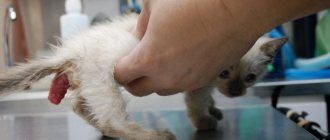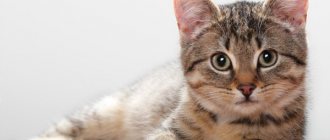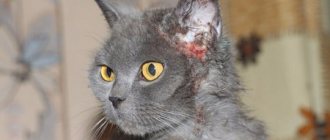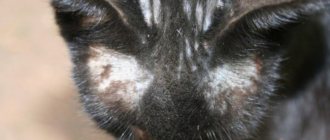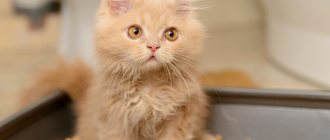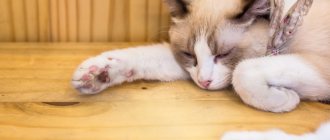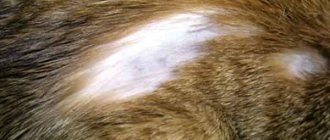False pregnancy occurs in all mammals, including humans. It happens much more often in dogs, but cat owners can also encounter this. Not so long ago, no treatment was carried out in a similar situation - the owners simply limited the animal’s food and distracted it, not allowing it to “build a nest.” Now doctors prescribe hormonal and sedative drugs to neutralize the effects on physiological processes.
Why does false pregnancy occur in cats?
The disease is caused by two types of reasons - some are responsible for physiology, and others are responsible for the psyche. With a physiological mechanism, the mechanism is as follows: the animals had sexual contact, but something went wrong; Hormonal imbalances also relate to physiology. Psychological reasons are more difficult to understand, since they are unpredictable.
- The problem is with the partner
. The cat has a reproductive disorder or was recently neutered, so fertilization has not occurred, but psychologically the mechanism has started in the female.
- The problem is with the female herself.
– she, too, may not have everything in order with reproduction, this includes organ diseases and developmental anomalies.
- Hormonal imbalances
. The functioning of the endocrine system can be disrupted due to a number of diseases.
- Severe or prolonged stress
: moving, transfer to another family, long-term absence of the owner to whom the pet is strongly attached, if it is lost, etc.
- The presence of other pregnant females nearby
, even a different type. A kind of “envy” can provoke the manifestation of signs that lead the pet to the desired state, even if only in her imagination. Therefore, owners of several females need to be attentive to all if one of them is mated.
Regardless of the reasons that caused false pregnancy in cats, the symptoms and treatment will be similar in all cases.
Causes of the condition
The presence of diabetes in an animal contributes to the development of this condition. In dogs, imaginary pregnancy develops more often than in cats due to differences in the reproductive cycle. Lifestyle also influences the development of the condition. Cats love solitude and prefer to take care only of themselves, and dogs are pack animals, so if the mother dies, a dog with a phantom pregnancy can feed someone else’s offspring. False pregnancy often occurs after sterilization, when the body’s production of hormones increases. The imaginary condition occurs in domestic cats if the following provoking factors are present:
- disruption of the production of thyroid hormones;
- ovarian neoplasms;
- inflammation of the endometrium of the uterus;
- uterine tumors;
- sexual intercourse with a castrated cat;
- stressful situations;
- age-related changes resulting in hormonal imbalance;
- examination of the internal genital organs using a smear test;
- observation of a non-pregnant cat of individuals bearing offspring;
- diabetes.
Symptoms of false pregnancy
The picture of the disease consists of physical symptoms that appear due to the fact that the brain gives the body incorrect signals, and from subjective behavioral signs. Based on their combination, the owner can notice something is wrong and contact a specialist.
Physiological signs
The physiology of pseudo-pregnancy is not much different from the physiology of a really pregnant mustachioed lady. If there is a false pregnancy in cats, the signs will be as follows:
- mucous discharge from the vulva;
- some bloating;
- swelling of the nipples and possible separation of colostrum;
- increased appetite;
- nausea, vomiting, diarrhea;
- rise in body temperature.
Symptoms may be present together or separately. Some “pretenders” tolerate this condition easily and practically do not “weird” in terms of behavior, and in some it reaches serious mental disorders.
Behavioral signs
They appear if false pregnancy in cats is complicated. Signs of the behavioral spectrum:
- mood swings sharply;
- change in habitual behavior: wild harpies may begin to show irrepressible love, and tame purrs, on the contrary, hiss and run away;
- apathy towards games;
- drowsiness;
- nesting;
- imitation of parenthood: carrying small objects, trying to breastfeed them and other symptoms of “adoption”.
If this behavior, coupled with physiological manifestations, continues, contact a specialist to select treatment.
Diagnosis at home and at the veterinarian
If owners notice that a false pregnancy has occurred in cats, it is better to double-check the symptoms and treatment at the veterinary clinic. If there is no mating, do not hesitate to consult a doctor. If the female tolerates the condition easily, her behavior does not change, you can wait a couple of weeks - most likely, the signs will go away on their own. If the mental state of the imaginary pregnant woman is severe, it is better to take her to the veterinary clinic as soon as possible.
After a mating has occurred, the symptoms are quite expected, and the doctor will be able to confirm the presence or absence of a special situation in 2-3 weeks using instrumental methods.
Homeopathic remedies
- Ovariovitis
- Ovarium Compositum
- Phytoelite Cytostat
- Gormel
- Galastop
OvariovitisA complex homeopathic medicine that restores hormonal levels, normalizes sexual cycles and neutralizes mental disorders. For the treatment and prevention of pseudopregnancy in dogs.
|
Ovarium CompositumA complex homeopathic remedy that normalizes hormonal levels and restores sexual cycles. Used to eliminate behavioral changes during pseudopregnancy and neutralize its clinical manifestations.
|
Phytoelite CytostatHerbal medicine for the prevention of mammary gland cancer in animals against the background of mastitis and pseudopregnancy.
|
|
GalastopHerbal solution for regulating milk secretion and treating mastopathy and mastitis in animals. Affects the level of prolactin production.
|
Treatment of false pregnancy in cats
A sick dog will be prescribed treatment, but the owner is also able to alleviate the pet’s plight. More recently, no drug therapy existed, and animals were not treated at all or folk remedies were used.
What should the owner do?
How to calm a pseudo-pregnant woman at home in order to avoid drug treatment if possible?
- it is advisable to switch the pet completely to drying during this time if it is on mixed feeding;
- if the cat eats natural food, completely remove dairy products from the diet, reduce protein (meat, fish) and increase the proportion of carbohydrate foods (porridge, cereals) - to prevent lactation;
- with water there are no clear recommendations: some veterinarians recommend reducing the amount of water, while others do not limit access to it;
- Show more attention to your pet: pick it up, stroke it, play, talk;
- remove objects of care and dismantle “family nests”.
If a really pregnant dog or cat lives nearby, it is better to separate the females at least into different rooms, or better yet, temporarily house them.
What medications will the veterinarian prescribe?
If, despite all the measures taken, the cat’s false pregnancy does not go away, treatment and medications should be prescribed by a veterinarian. Typically this is the following list of drugs:
- sedative therapy in the form of mild sedatives, such as “Antistress”, “Xyzalin”;
- Hormone therapy is carried out for long or frequent false pregnancies and always for mastitis;
- vitamin and mineral complexes are prescribed to maintain immunity and normal functioning of the body;
- Antibiotic therapy is required for mastitis.
In the early stages, treating false pregnancy is much easier and safer for the cat’s body, so do not delay your visit to the clinic.
Folk remedies
If milk is not produced, but your pet has severe nipple swelling, you can alleviate her condition by applying a compression bandage soaked in cabbage juice or aloe leaf pulp. A gentle massage of the mammary glands helps a lot, in which it is better to use special means to stop lactation - gels, ointments, creams. But you cannot self-medicate mastitis, therefore, if symptoms of inflammation suddenly appear, you should consult a doctor.
Possible complications
The state of pseudopregnancy in itself is not scary for an animal. The danger is caused by serious complications, which in severe and advanced cases can lead to the death of the pet.
Mastitis
The production of milk in a mother who is going to feed her offspring is quite physiological. But the birth of kittens is not expected, and lactation has started, producing empty milk that does not go anywhere. If you do nothing to help the mammary glands avoid stagnation, then you are not far from mastitis - an infectious-inflammatory, often purulent process. It must be treated with antibiotics, and in difficult cases, a unilateral or bilateral mastectomy (removal of the entire strip of mammary glands) can be performed.
Pyometra
Pseudopregnancy can also cause a disease such as pyometra - inflammation of the uterus with the accumulation of purulent contents in it. Conservative drug treatment is possible only in the initial stage of the disease, but most often, in order to save the animal’s life, surgical removal of the uterus and ovaries is performed.
Severe psychological condition
Often the psychoneurotic reaction of the central nervous system depresses imaginary expectant mothers and causes serious mental disorders that can be dangerous for people. Murki can seriously protect their newly-made “children” from attacks, rush at their owners, scratch and bite. They are able to turn their anger on the home environment, causing serious damage to furniture, wallpaper and other surfaces in the house. Such furies must be prescribed sedative therapy, and you should not wait 2-3 weeks and hope that everything will go away on its own.
Why is pathology dangerous?
So why is imaginary pregnancy dangerous in cats? To many:
- Since these pets often develop it for a reason, but against the background of quite serious hormonal disorders or pathologies of the reproductive system, with special “luck” it can lead to oncology.
- It has been noticed that cats that have had an “empty” pregnancy two or more times in a row are subsequently practically useless from the point of view of reproduction. They either become worse pregnant, or their offspring are weak and nonviable.
- The likelihood of pyometra, chronic endometritis and ovarianitis (inflammation of the uterus and ovaries, respectively) increases.
Mastitis during false pregnancy
But still, more often than not, cat owners face another problem. Mastitis during false pregnancy occurs very often. The problem is that cats themselves are extremely difficult to tolerate inflammation of the mammary glands; the risk of death is quite high.
The mechanism of mastitis development in this case is very simple:
- Since during a false pregnancy milk secretion occurs regularly, but there is no one to suck it out, the liquid constantly accumulates in the alveoli and milk ducts.
- Gradually, the pressure becomes such that the milk flows by gravity (sometimes with force, as if from a spray bottle) out of the nipples.
- If these streaks are not removed in time and the skin is not wiped, the milk turns sour, creating excellent conditions for the development of pathogenic and conditionally pathogenic microflora. Gradually, the microbes will penetrate into the mammary gland itself and cause inflammation there.
With this pathology, the nipples and adjacent tissues become very hard, and local and general body temperature rises. The slightest touch to the nipples results in inappropriate behavior of the animal, to which palpation causes unbearable pain.
Important! Treatment in a clinical setting is urgently required, as otherwise the cat could easily die.
In particular, with the slightest delay, inflammation easily turns into a purulent form, when thick, yellow-green pus begins to secrete from the nipples. The probability of successful treatment is 50/50 (in other words, depending on your luck). In addition, in advanced cases, sterilization is almost always required.
Sterilization and its connection with false pregnancy
Sterilization, that is, removal of the uterus and ovaries, is a radical way to combat false pregnancy. The necessary hormones are not produced, and the condition becomes impossible, so frequently recurring similar hormonal disorders are a clear indication for sterilization. If the individual is a breeder, it is not at all necessary to sterilize it after the first unsuccessful mating; first you need to try to find out the cause of the problem. Perhaps, after a change of partner or after treatment, the pet will be able to have offspring, and the disease will not recur.
Surgery is recommended if the owner does not intend to breed the pet - after sterilization, the pet will be free from diseases of the reproductive system in the future, and, perhaps, will live several more years of life.
What to do as a preventive measure
As a preventive measure, you need to follow the correct diet and do not overfeed your pet, as this can cause both metabolic and hormonal system failure.
There is no need to mate your fluffy princess with just anyone: it is better to mate with a trusted manufacturer, and then, at least, in case of failure, you will not have to wonder whether the problem was with the male.
Limit communication with pregnant and calving females, play, pay more attention, communicate with the animal. Monitor your cat's hormonal status and treat all diseases in a timely manner.
If the condition recurs often, it is better to sterilize even the breeding individual, because this feature is inherited.
Although false pregnancy is not a common disease in cats, carefully monitor your pet after estrus, especially purebred females at risk, try not to stress her, provide an atmosphere of love and attention, and in case of any alarming manifestations in behavior, contact a specialist.
The article is for informational purposes only. Contact your veterinarian!

